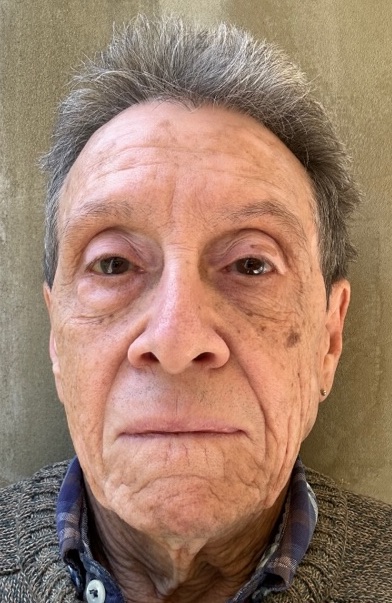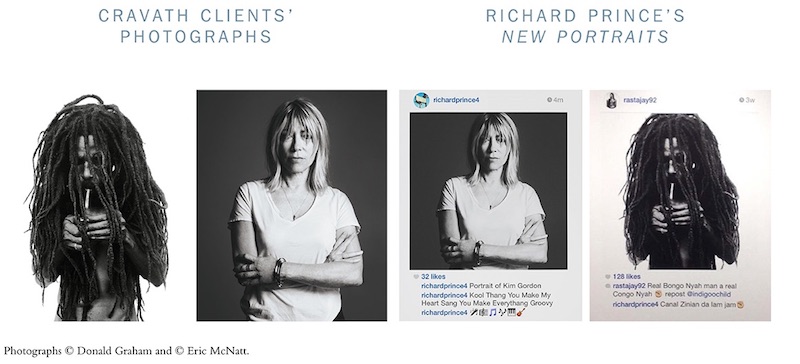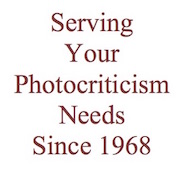
[In spring and summer of 2018 I served as an expert witness in Graham v. Prince et al (15‑cv‑10160) and McNatt v. Prince et al (16‑cv‑08896), providing my services pro bono
At the time I got involved, these cases — filed against wealthy “appropriation art” practitioner and serial hacker Richard Prince by photographers Donald Graham and Eric McNatt for Prince’s unauthorized use of their images — were merged, so my testimony applied to both. Subsequently the cases got separated. Recently, as they headed to trial, they got settled. (See “Richard Prince to Pay Photographers Over $650,000 In Copyright Lawsuits,” by Pesala Bandara, PetaPixel, January 29, 2024.)
I like to think that my rebuttal contributed in some ways to the court’s decision, and also that it makes interesting reading in its own right. (It pleases me to report that Prince and his attorneys repeatedly asked the court to exclude my testimony, which request the court repeatedly denied.) As it’s now on the record as a public document, and the cases have resolved, I’m publishing it here. I’ve stripped out some of the boilerplate — my credentials, etc. — to make it more readable.
Part 3 appears below. Click here for part 1, here for part 2, and here for part 4. If you prefer to read the whole thing, complete with professional boilerplate, you can download a PDF of the brief here.— A.D.C.] — A.D.C.]
•
U.S. District Court for the Southern District of New York
Case No. 1:16-cv-08896-SHS
Rebuttal Report of Allan Douglass Coleman (c)
… Let me explain via an example from my own work as a critic and historian. For the past four years, I have pursued and supervised an investigation of the production and subsequent fate of Robert Capa’s ten iconic photographs of U.S. troops landing on Omaha Beach on D-Day, June 6, 1944 (Alternate History: Robert Capa on D-Day). This research has won a prestigious award, stirred considerable controversy, and forced an emerging revision of the Capa literature.
In the process of conducting this inquiry I have become extremely familiar with the literature on Capa and these famous images, which includes familiarity with a cross-section of the ways in which those photographs have reached the public, both at the time and over the past 70 years. Publications authorized by Capa himself and, after his death in 1954, by his estate include countless appearances of one or more of these images in a wide assortment of print media: books, magazines, newspapers, posters, record-album inserts, posthumous digital “estate prints” on archival papers, even the cover of a U.S. Post Office folder holding commemorative D-Day stamps.
 They have also appeared as what we now call “vintage” original press prints made from the original negatives on photographic paper and distributed to various publications at the time of their making; as posthumous prints made from the original negatives (and, in a few cases, from copy negatives) on photographic paper and distributed to various publications or put on display in exhibitions; as estate-authorized editioned prints on photographic paper; as estate-authorized digital ink-jet prints; and as digital-image files published online at such websites as those of Magnum Photos (a picture agency co-founded by Capa, headquartered in New York City) and the ICP, founded by Capa’s younger brother Cornell (also located in New York City).
They have also appeared as what we now call “vintage” original press prints made from the original negatives on photographic paper and distributed to various publications at the time of their making; as posthumous prints made from the original negatives (and, in a few cases, from copy negatives) on photographic paper and distributed to various publications or put on display in exhibitions; as estate-authorized editioned prints on photographic paper; as estate-authorized digital ink-jet prints; and as digital-image files published online at such websites as those of Magnum Photos (a picture agency co-founded by Capa, headquartered in New York City) and the ICP, founded by Capa’s younger brother Cornell (also located in New York City).
In all these cases the size and format of the original images as registered on Capa’s negatives have been changed via their production in a variety of sizes in different photographic media and an assortment of ink-reproduction media, as well as the digital formats involved in their online presentations. Furthermore, in almost every case these presentations have included texts, most of them different from each other and the vast majority of them not authored by Capa himself, but by picture editors and caption writers at various publications; by war historians contextualizing them in accounts of D-Day; by photo historians contextualizing them in survey exhibitions of war photography and/or retrospectives of Capa’s work; and by others.
Indeed, Mr. Wallis himself may well have provided such texts in one or another circumstance. In any case, having worked for many years at the ICP, often in collaboration with Magnum Photos, and having taken a particular interest in Capa’s work, Mr. Wallis is surely aware of the many authorized forms in which those images of Capa’s have appeared.
 Logically, applying Wallis’ argument on Mr. Prince’s behalf to these versions of Capa’s images, each of these instances of the “recontextualized” publication or other presentation of any of Capa’s D-Day images effectively created a new, unique work — the selfsame claim made in regard to Mr. Prince’s appropriations. But this would be an absurd result. As I understand it, these “new works” are instead derivative works that, if not produced by Capa himself or his estate, would require licensing under the copyright law. In my opinion, the same would hold for Mr. Prince’s appropriated versions of the Instagram posts he used in the works at issue in this case.
Logically, applying Wallis’ argument on Mr. Prince’s behalf to these versions of Capa’s images, each of these instances of the “recontextualized” publication or other presentation of any of Capa’s D-Day images effectively created a new, unique work — the selfsame claim made in regard to Mr. Prince’s appropriations. But this would be an absurd result. As I understand it, these “new works” are instead derivative works that, if not produced by Capa himself or his estate, would require licensing under the copyright law. In my opinion, the same would hold for Mr. Prince’s appropriated versions of the Instagram posts he used in the works at issue in this case.
My Capa research also led me to numerous unauthorized uses of Capa’s D-Day imagery: as third- or fourth-generation copy prints on photographic paper, or digitally ink-printed, signed by D-Day veterans and sold on eBay; on T-shirts sold as souvenirs of veterans’ reunions; on the cover of a self-published LP record of reminiscences by a D-Day veteran; on posters and collector trading cards; and in other forms of presentation.
In all cases they come in formats that do not represent the formats in which Capa or his estate have issued or authorized them; in most cases they come accompanied by texts — ranging from veterans’ signatures to the dates and times of reunions to historical information about Capa and/or D-Day. All of these items are or were originally made for sale, not for educational purposes, and thus constitute commercial usages.
According to Mr. Wallis’s formulation, these unauthorized usages are perfectly legal in that they constitute new works under the “fair use” exemption. Again, this would be an absurd result.
•
This raises another question broached by Mr. Wallis — his assertion that, as a general principle, “comment” automatically constitutes an “alteration” even when said “comment” comprises nothing more than what Mr. Prince acknowledges is “gobblygook” (sic). I find this assumption arguable, to say the least. If even incomprehensible prose inherently represents the activity we call “commenting,” then all speech qualifies as commentary, in which case the “comment” requirement of the “fair use” exception becomes meaningless.

Comparison of Donald Graham and Eric McNatt photos to Richard Prince derivations, Cravath, Swaine & Moore LLP website, screenshot
•
Furthermore, given the nature of Mr. Prince’s “comments,” it is impossible to determine whether he is “commenting” on the images involved in these Instagram posts, the original texts that accompanied them in these online presentations, or the combination of the two. As a critic, I find this distinction significant, because I consider those Instagram posts to constitute what I refer to as image-text works. That is, by the choice of whoever posted them, these posts involve an intentional combination of images and texts. From a critical standpoint, they therefore require analysis as integrated wholes. And what Mr. Prince “appropriated” are those wholes, not just the separate elements thereof.
However, given the fact that neither Mr. Graham nor Mr. McNatt authored or otherwise authorized those Instagram posts, the images (included therein without their permissions) require consideration as separate elements. After all, it is these two photographers, and not the person or persons who posted the images to Instagram, who pursue this claim. And this claim pertains only to their images, not to accompanying text in the posts. Consequently, one must address Mr. Prince’s use of the images in assessing the purportedly “transformative” aspect of his derivative works.
 Arguably, the texts inserted into these posts by Mr. Prince do transform the original text offered by the person or persons who posted them, if only by establishing a question-and-answer, call-and-response dialogic dynamic. But that does not automatically constitute a transformation of the original images, taken as autonomous works unto themselves.
Arguably, the texts inserted into these posts by Mr. Prince do transform the original text offered by the person or persons who posted them, if only by establishing a question-and-answer, call-and-response dialogic dynamic. But that does not automatically constitute a transformation of the original images, taken as autonomous works unto themselves.
Nor does it automatically constitute a transformation of the derivative versions of those images as they appear in these posts. To argue otherwise, as do Mr. Wallis and Mr. Prince’s additional defenders, is to propose that all those authorized and unauthorized variants of Capa’s D-Day images (and indeed, any republishing of a photograph with a different text caption) constitute “transformations” under the copyright law. …
•
This post supported in part by a donation from Charles Mintz.
•

Special offer: If you want me to either continue pursuing a particular subject or give you a break and (for one post) write on a topic — my choice — other than the current main story, make a donation of $50 via the PayPal widget below, indicating your preference in a note accompanying your donation. I’ll credit you as that new post’s sponsor, and link to a website of your choosing.
And, as a bonus, I’ll send you a signed copy of my new book, poetic license / poetic justice — published under my full name, Allan Douglass Coleman, which I use for my creative writing.





Leave a Comment